SEO
7 Ways To Use Google Trends For SEO & Content Marketing

Google Trends is a surprisingly useful tool for keyword research, especially when using advanced search options that are virtually hidden in plain sight.
Explore the different Google Trends menus and options and discover seemingly endless ways to gain more keyword search volume insights.
Learn new ways to unlock the power of one of Google’s most important SEO tools.
The Value Of Google Trends
While Google Trends is accurate, it doesn’t show the amount of traffic in actual numbers.
It shows the numbers of queries made in relative percentages on a scale of zero to 100.
Unlike Google Trends, paid SEO tools provide traffic volume numbers for keywords.
But those numbers are only estimates that are extrapolated from a mix of internet traffic data providers, Google Keyword Planner, scraped search results, and other sources.
The clickstream data usually comes from anonymized traffic data acquired from users of certain pop-up blockers, browser plugins, and some free anti-virus software.
The SEO tools then apply a calculation that corresponds to their best guess of how that data correlates with Google keyword search and traffic volume.
So, even though paid SEO tools provide estimates of keyword traffic, the data presented by Google Trends is based on actual search queries and not guesses.
That’s not to say that Google Trends is better than paid keyword tools. When used together with paid keyword tools, one can obtain a near-accurate idea of true keyword search volume.
There are other functions in Google Trends that can help dial in accurate segmentation of the keyword data that helps to understand what geographic locations are best for promotional efforts and also discover new and trending keywords.
How To Use Google Trends For SEO
1. Get More Accurate Data By Comparing Keywords
Google Trends shows a relative visualization of traffic on a scale of zero to 100.
You can’t really know if the trend is reporting hundreds of keyword searches or thousands because the graph is on a relative scale of zero to one hundred.
However, the relative numbers can have more meaning when they are compared with keywords for which there are known traffic levels from another keyword phrase.
One way to do this is to compare keyword search volume with a keyword whose accurate traffic numbers are already known, for example, from a PPC campaign.
If the keyword volume is especially large for which you don’t have a keyword to compare, there’s another way to find a keyword to use for comparison.
A comparison keyword doesn’t have to be related. It can be in a completely different vertical and could even be the name of a trending celebrity.
The important thing is the general keyword volume data.
Google publishes a Google Trends Daily Trends webpage that shows trending search queries.
What’s useful about this page is that Google provides keyword volumes in numbers, like 100,000+ searches per day, etc.
Example Of How To Pinpoint Search Volume
I’m going to use the search phrase [how to lose weight] as an example of how to use Google Trends to get a close idea of actual search volume.
The way I do it is by using known search volumes and comparing them to the target keyword phrase.
Google provides search volumes on its trending searches page, which can be adjusted for what’s trending in any country.
On this particular day (September 22, 2022), the actress Ana De Armas was trending with 50,000+ searches, and the American ex-football player (keyword phrase [Bret Favre News]) was trending with 20,000+ searches.
Step 1. Find Search Trends For Target Keyword Phrases
The target keyword phrase we’re researching is [how to lose weight].
Below is a screenshot of the one-year trend for the target keyword phrase:
As you can see, it’s a fairly stable trend line from September 2021 to September 2022.
Then I added the two keyword phrases for which we have a close search volume count to compare all three, but for a 24-hour time period.
I use a 24-hour time period because the search volume for our comparison keywords is trending for this one day.
 Screenshot from Google Trends, September 2022
Screenshot from Google Trends, September 2022Our target keyword phrase, with a red trend line, is right in the middle, in between the keyword phrases [Ana De Armas] (blue) and [Bret Favre News] (yellow).
What the above comparison tells us is that the phrase [how to lose weight] has a keyword volume of more than 20,000+ searches but less than 50,000+ searches.
The relative search volume of [how to lose weight] is 50% of the keyword phrase [Ana De Armas].
Because we know that [Ana De Armas] has a search volume of approximately 50,000+ searches on this particular day, and [Bret Favre News] has a search volume of 20,000+ queries on the same day, we can say with reasonable accuracy that the keyword phrase, [how to lose weight] has approximately a daily search volume of around 30,000 on an average day, give or take a few thousand.
The actual numbers could be higher because Google Trends shows the highs and lows at particular points of the day. The total for the day is very likely higher.
The above hack isn’t 100% accurate. But it’s enough to give a strong ballpark idea and can be used to compare with and validate extrapolated data from a paid keyword research tool.
Related: How To Do Keyword Research For SEO
2. Discover Insights From Time-based Trends
There are two general ways to look at the keyword data: stretched across over longer periods of time and shorter time periods.
Long Period Trends
You can set Google Trends to show you the traffic trends stretching back to 2004. This is valuable for showing you the audience trends.
- Upward Long-Term Trends: If a trend is consistently going up, this means you need to focus energy on creating content for this trend.
- Downward Long-Term Trends: If the trend line is steadily moving down, then it may be a signal that audience content consumption is changing.
For example, review this five-year trend for [WordPress] the search term, WordPress the software, and WordPress the website:
 Screenshot from Google Trends, September 2022
Screenshot from Google Trends, September 2022There’s a clear downward trend for WordPress in all three variations.
The downward trend extends to related phrases such as:
- WordPress themes.
- WordPress plugin.
- WordPress hosting.
There are many reasons why search trends go down. It can be that people lost interest, that the interest went somewhere else or that the trend is obsolete.
The digital camera product category is a good example of a downward spiral caused by a product being replaced by something else.
- The digital camera caused the downturn in searches for traditional analog cameras.
- The iPhone started the downward spiral of the digital camera.
Knowing which way the wind is blowing could help a content marketer or publisher understand when it’s time to bail on a topic or product category and to pivot to upward-trending ones.
Related: Content Marketing: The Ultimate Beginner’s Guide
3. Related Topics And Queries
Google Trends has two great features, one called Related Topics and the other Related Queries.
Topics
Topics are search queries that share a concept.
Identifying related topics that are trending upwards is useful for learning how an audience or consumer demand is shifting.
This information can, in turn, provide ideas for content generation or new product selections.
According to Google:
“Related Topics
Users searching for your term also searched for these topics.
You Can View by the Following Metrics
Top – The most popular topics. Scoring is on a relative scale where a value of 100 is the most commonly searched topic and a value of 50 is a topic searched half as often as the most popular term, and so on.
Rising – Related topics with the biggest increase in search frequency since the last time period.
Results marked “Breakout” had a tremendous increase, probably because these topics are new and had few (if any) prior searches.”
Related Queries
The description of Related Queries is similar to that of the Related Topics.
Top queries are generally the most popular searches. Rising Queries are queries that are becoming popular.
 Screenshot from Google Trends, September 2022
Screenshot from Google Trends, September 2022The data from Rising Queries are great for staying ahead of the competition.
4. Short-Term Trends Can Bring Massive Traffic
Viewing keyword trends in the short view, such as the 90-day or even 30-day view, can reveal valuable insights for capitalizing on rapidly changing search trends.
There is a ton of traffic in Google Discover as well as in Google News.
Google Discover is tied to trending topics related to searches.
Google News is of the moment in terms of current events.
Sites that target either of those traffic channels benefit from knowing what the short-term trends are.
A benefit of viewing short-term trends (30 days and 90 trends) is that certain days of the week stand out when those searches are popular.
Knowing which days of the week interest spikes for a given topic can help in planning when to publish certain kinds of topics, so the content is right there when the audience is searching for it.
5. Keywords By Category
Google Trends has the functionality for narrowing down keyword search query inventory according to category topics.
This provides more accurate keyword data.
The Categories tab is important because it refines your keyword research to the correct context.
If your keyword context is [automobiles], then it makes sense to appropriately refine Google Trends to show just the data for the context of auto.
By narrowing the Google Trends data by category, you will be able to find more accurate information related to the topics you are researching for content within the correct context.
6. Identify Keyword Data By Geography
Google Trends keyword information by geographic location can be used for determining what areas are the best to outreach to for site promotion or for tailoring the content to specific regions.
For example, if certain kinds of products are popular in Washington D.C. and Texas, it makes sense to aim promotional activity and localized content to those areas.
In fact, it might be useful to focus link-building promotional activities in those areas first since the interest is higher in those parts of the country.
Keyword popularity information by region is valuable for link building, content creation, content promotion, and pay-per-click.
Localizing content (and the promotion of that content) can make it more relevant to the people who are interested in that content (or product).
Google ranks pages according to who it’s most relevant, so incorporating geographic nuance into your content can help it rank for the most people.
7. Target Search Intents With Search Types
Google Trends gives you the ability to further refine the keyword data by segmenting it by the type of search the data comes from, the Search Type.
Refining your Google Trends research by the type of search allows you to remove the “noise” that might be making your keyword research fuzzy and help it become more accurate and meaningful.
Google Trends data can be refined by:
- Web Search.
- Image Search.
- News Search.
- Google Shopping.
- YouTube Search.
 Screenshot from Google Trends, September 2022
Screenshot from Google Trends, September 2022YouTube search is a fantastic way to identify search trends for content with the word “how” because a lot of people search on YouTube using phrases with the words “how” in them.
Although these are searches conducted on YouTube, the trends data is useful because it shows what users are looking for.
A Google Trends search for how, what, where, when, why, and who shows that search queries beginning with the word “how” are by far the most popular on YouTube.
Google Trends limits comparisons to five keywords, so the following screenshot omits that word.
 Screenshot from Google Trends, September 2022
Screenshot from Google Trends, September 2022If your keyword phrases involve instructional content that uses words like “how to,” refining your research with the YouTube search type may provide useful insights.
For example, I have found that YouTube Search shows more relevant “related topics” and “related queries” data than researching with “web search” selected.
Here’s another example of how using different kinds of search types helps refine Google Trends data.
I did the same how, what, where, when, why, and who searches but this time using the News Search refinement.
 Screenshot from Google Trends, September 2022
Screenshot from Google Trends, September 2022The search trends in Google News are remarkably different than the search patterns on YouTube. That’s because people want to know the “what” and “how” types of information in Google News.
When creating content related to news, identifying the correct angle to report a news item is important.
Knowing that the words “what” or “who” are most relevant to a topic can be useful for crafting the title to what the readers are most interested in.
The above is the view of search queries for the past 90 days.
When the same keywords are searched using the 5-year perspective, it becomes clear that the “who” type keywords tend to spike according to current events.
As an example of how current events influence trends, the biggest spike in searches with the word “who” occurred in the days after the 2020 presidential election.
Every Search Type query refinement shows a different help to refine the results so that they show more accurate information.
So, give the Search Type selections a try because the information that is provided may be more accurate and useful than the more general and potentially noisy “web search” version.
Unlock The Hidden Power Of Google Trends
Free tools are generally considered to be less useful than paid tools. That’s not necessarily the case with Google Trends.
This article lists seven ways to discover useful search-related trends and patterns that are absolutely accurate, more than some search-related data from paid tools.
What’s especially notable is that this article only begins to scratch the surface of all the information that’s available.
Check out Google Trends and learn additional ways to mix different search patterns to obtain even more useful information.
More Resources:
Featured Image: Studio Romantic/Shutterstock
SEO
How To Use ChatGPT For Keyword Research

Anyone not using ChatGPT for keyword research is missing a trick.
You can save time and understand an entire topic in seconds instead of hours.
In this article, I outline my most effective ChatGPT prompts for keyword research and teach you how I put them together so that you, too, can take, edit, and enhance them even further.
But before we jump into the prompts, I want to emphasize that you shouldn’t replace keyword research tools or disregard traditional keyword research methods.
ChatGPT can make mistakes. It can even create new keywords if you give it the right prompt. For example, I asked it to provide me with a unique keyword for the topic “SEO” that had never been searched before.
“Interstellar Internet SEO: Optimizing content for the theoretical concept of an interstellar internet, considering the challenges of space-time and interplanetary communication delays.”
Although I want to jump into my LinkedIn profile and update my title to “Interstellar Internet SEO Consultant,” unfortunately, no one has searched that (and they probably never will)!
You must not blindly rely on the data you get back from ChatGPT.
What you can rely on ChatGPT for is the topic ideation stage of keyword research and inspiration.
ChatGPT is a large language model trained with massive amounts of data to accurately predict what word will come next in a sentence. However, it does not know how to do keyword research yet.
Instead, think of ChatGPT as having an expert on any topic armed with the information if you ask it the right question.
In this guide, that is exactly what I aim to teach you how to do – the most essential prompts you need to know when performing topical keyword research.
Best ChatGPT Keyword Research Prompts
The following ChatGPT keyword research prompts can be used on any niche, even a topic to which you are brand new.
For this demonstration, let’s use the topic of “SEO” to demonstrate these prompts.
Generating Keyword Ideas Based On A Topic
What Are The {X} Most Popular Sub-topics Related To {Topic}?
The first prompt is to give you an idea of the niche.
As shown above, ChatGPT did a great job understanding and breaking down SEO into three pillars: on-page, off-page & technical.
The key to the following prompt is to take one of the topics ChatGPT has given and query the sub-topics.
What Are The {X} Most Popular Sub-topics Related To {Sub-topic}?
For this example, let’s query, “What are the most popular sub-topics related to keyword research?”
Having done keyword research for over 10 years, I would expect it to output information related to keyword research metrics, the types of keywords, and intent.
Let’s see.
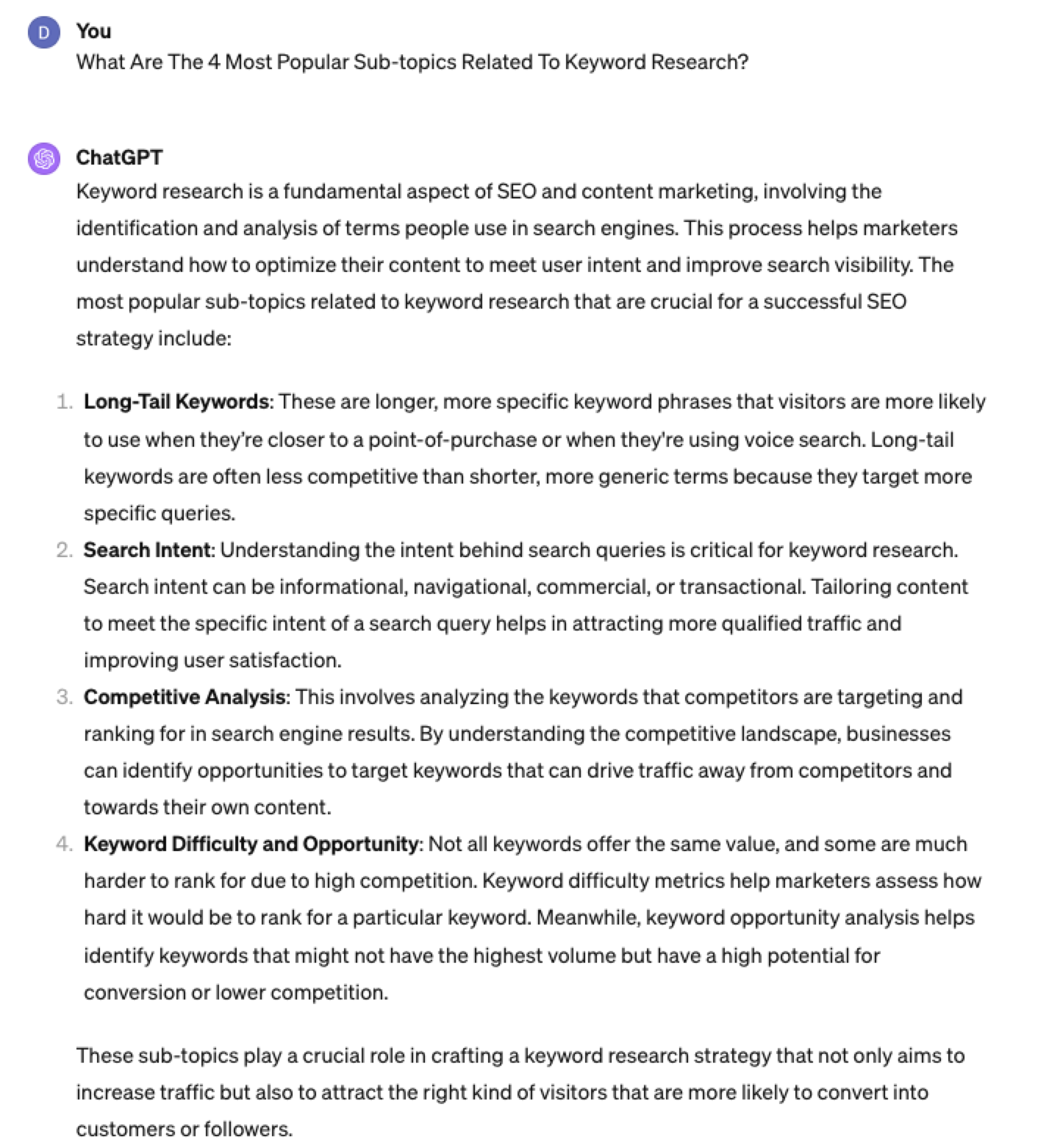 Screenshot from ChatGPT 4, April 2024
Screenshot from ChatGPT 4, April 2024Again, right on the money.
To get the keywords you want without having ChatGPT describe each answer, use the prompt “list without description.”
Here is an example of that.
List Without Description The Top {X} Most Popular Keywords For The Topic Of {X}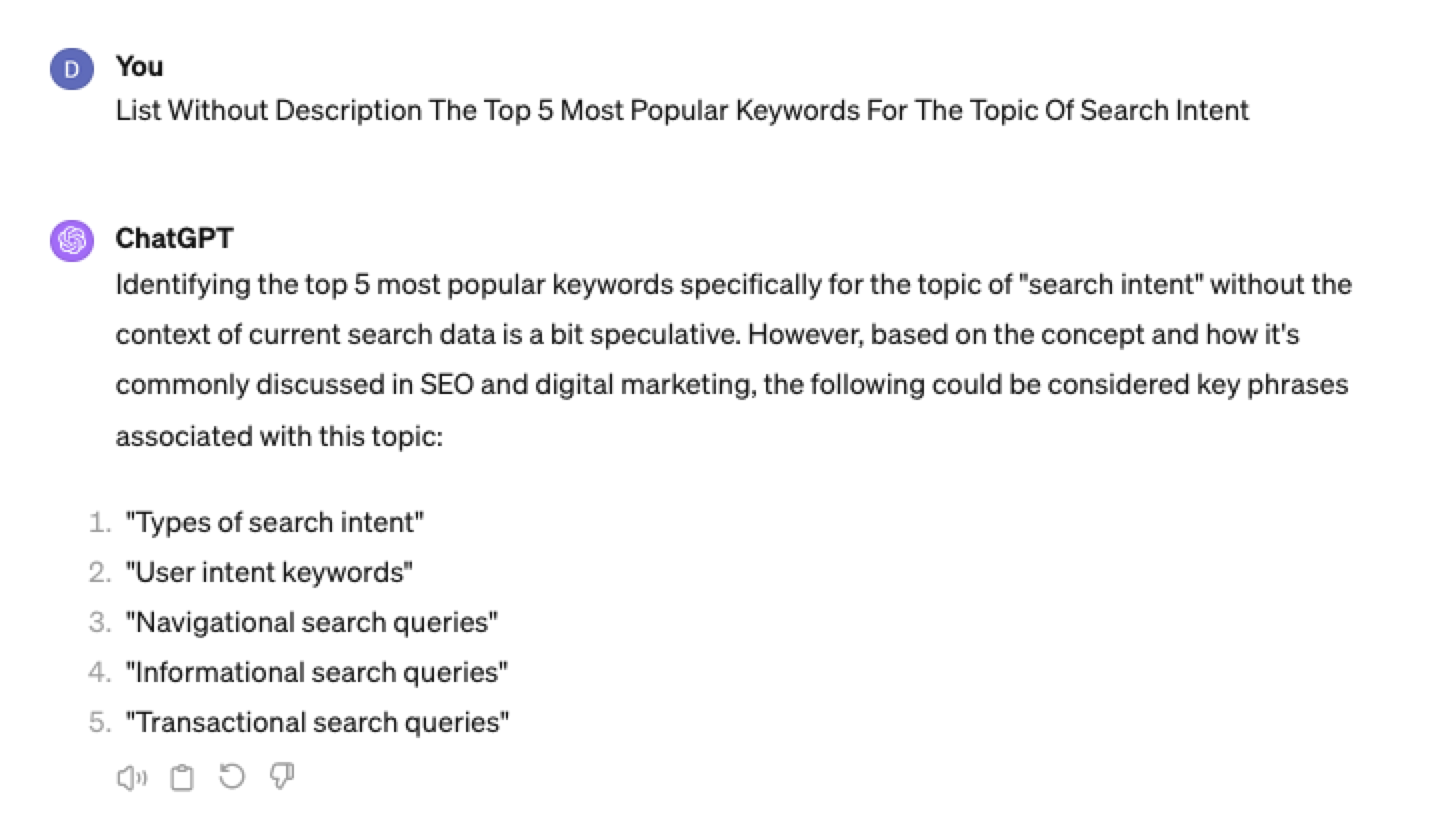
You can even branch these keywords out further into their long-tail.
Example prompt:
List Without Description The Top {X} Most Popular Long-tail Keywords For The Topic “{X}”
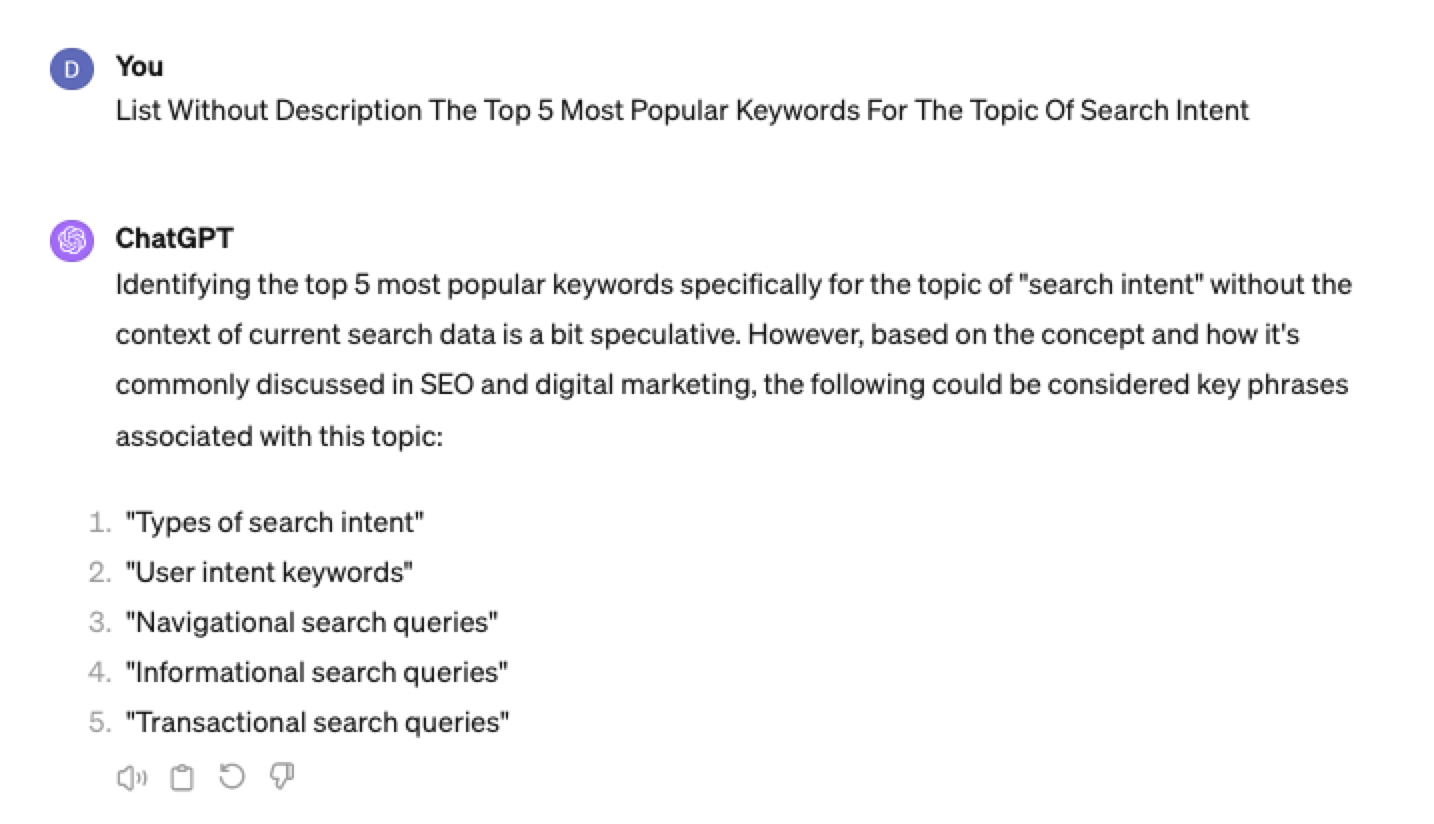 Screenshot ChatGPT 4,April 2024
Screenshot ChatGPT 4,April 2024List Without Description The Top Semantically Related Keywords And Entities For The Topic {X}
You can even ask ChatGPT what any topic’s semantically related keywords and entities are!
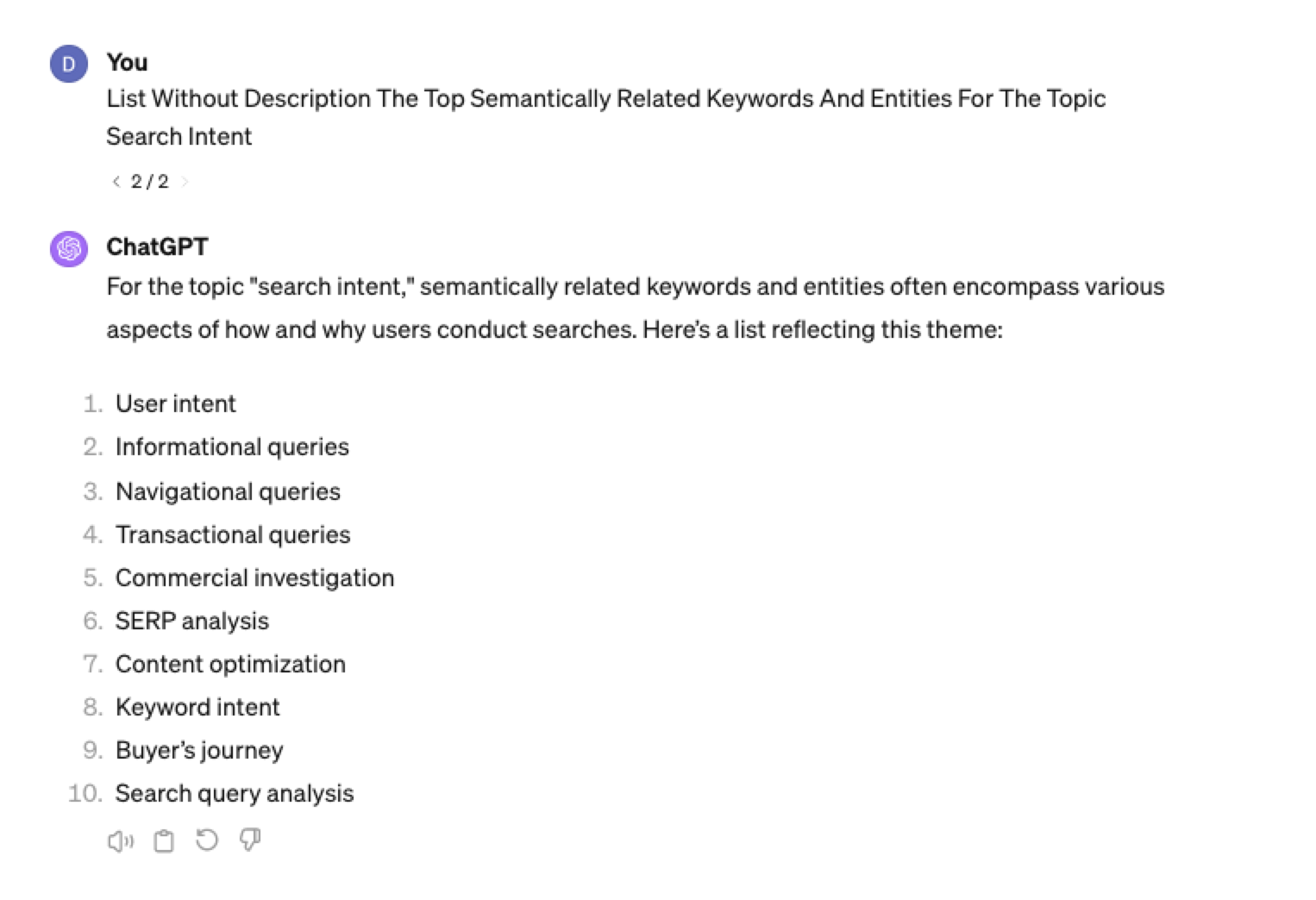 Screenshot ChatGPT 4, April 2024
Screenshot ChatGPT 4, April 2024Tip: The Onion Method Of Prompting ChatGPT
When you are happy with a series of prompts, add them all to one prompt. For example, so far in this article, we have asked ChatGPT the following:
- What are the four most popular sub-topics related to SEO?
- What are the four most popular sub-topics related to keyword research
- List without description the top five most popular keywords for “keyword intent”?
- List without description the top five most popular long-tail keywords for the topic “keyword intent types”?
- List without description the top semantically related keywords and entities for the topic “types of keyword intent in SEO.”
Combine all five into one prompt by telling ChatGPT to perform a series of steps. Example:
“Perform the following steps in a consecutive order Step 1, Step 2, Step 3, Step 4, and Step 5”
Example:
“Perform the following steps in a consecutive order Step 1, Step 2, Step 3, Step 4 and Step 5. Step 1 – Generate an answer for the 3 most popular sub-topics related to {Topic}?. Step 2 – Generate 3 of the most popular sub-topics related to each answer. Step 3 – Take those answers and list without description their top 3 most popular keywords. Step 4 – For the answers given of their most popular keywords, provide 3 long-tail keywords. Step 5 – for each long-tail keyword offered in the response, a list without descriptions 3 of their top semantically related keywords and entities.”
Generating Keyword Ideas Based On A Question
Taking the steps approach from above, we can get ChatGPT to help streamline getting keyword ideas based on a question. For example, let’s ask, “What is SEO?”
“Perform the following steps in a consecutive order Step 1, Step 2, Step 3, and Step 4. Step 1 Generate 10 questions about “{Question}”?. Step 2 – Generate 5 more questions about “{Question}” that do not repeat the above. Step 3 – Generate 5 more questions about “{Question}” that do not repeat the above. Step 4 – Based on the above Steps 1,2,3 suggest a final list of questions avoiding duplicates or semantically similar questions.”
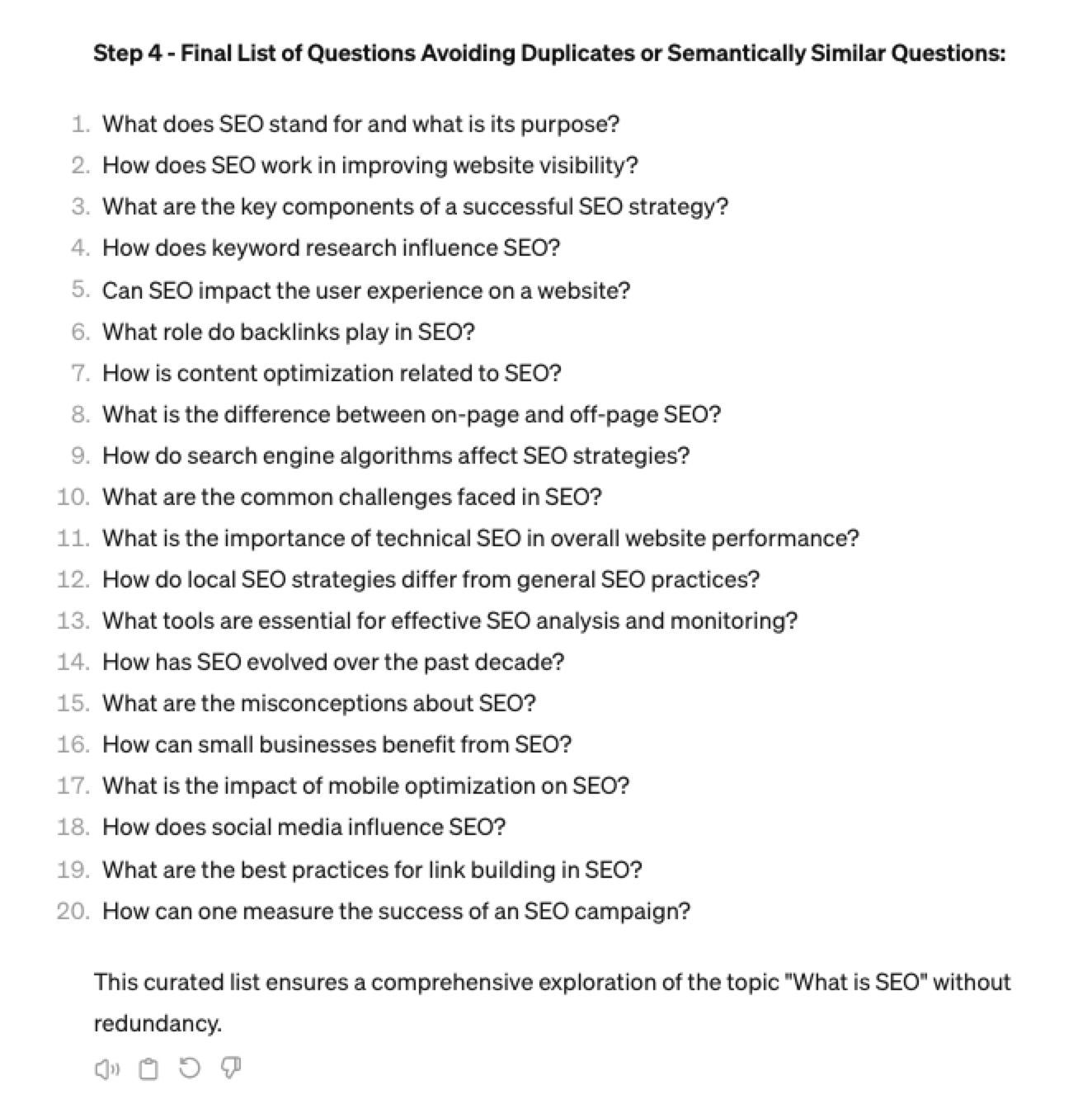 Screenshot ChatGPT 4, April 2024
Screenshot ChatGPT 4, April 2024Generating Keyword Ideas Using ChatGPT Based On The Alphabet Soup Method
One of my favorite methods, manually, without even using a keyword research tool, is to generate keyword research ideas from Google autocomplete, going from A to Z.
-
 Screenshot from Google autocomplete, April 2024
Screenshot from Google autocomplete, April 2024
You can also do this using ChatGPT.
Example prompt:
“give me popular keywords that includes the keyword “SEO”, and the next letter of the word starts with a”
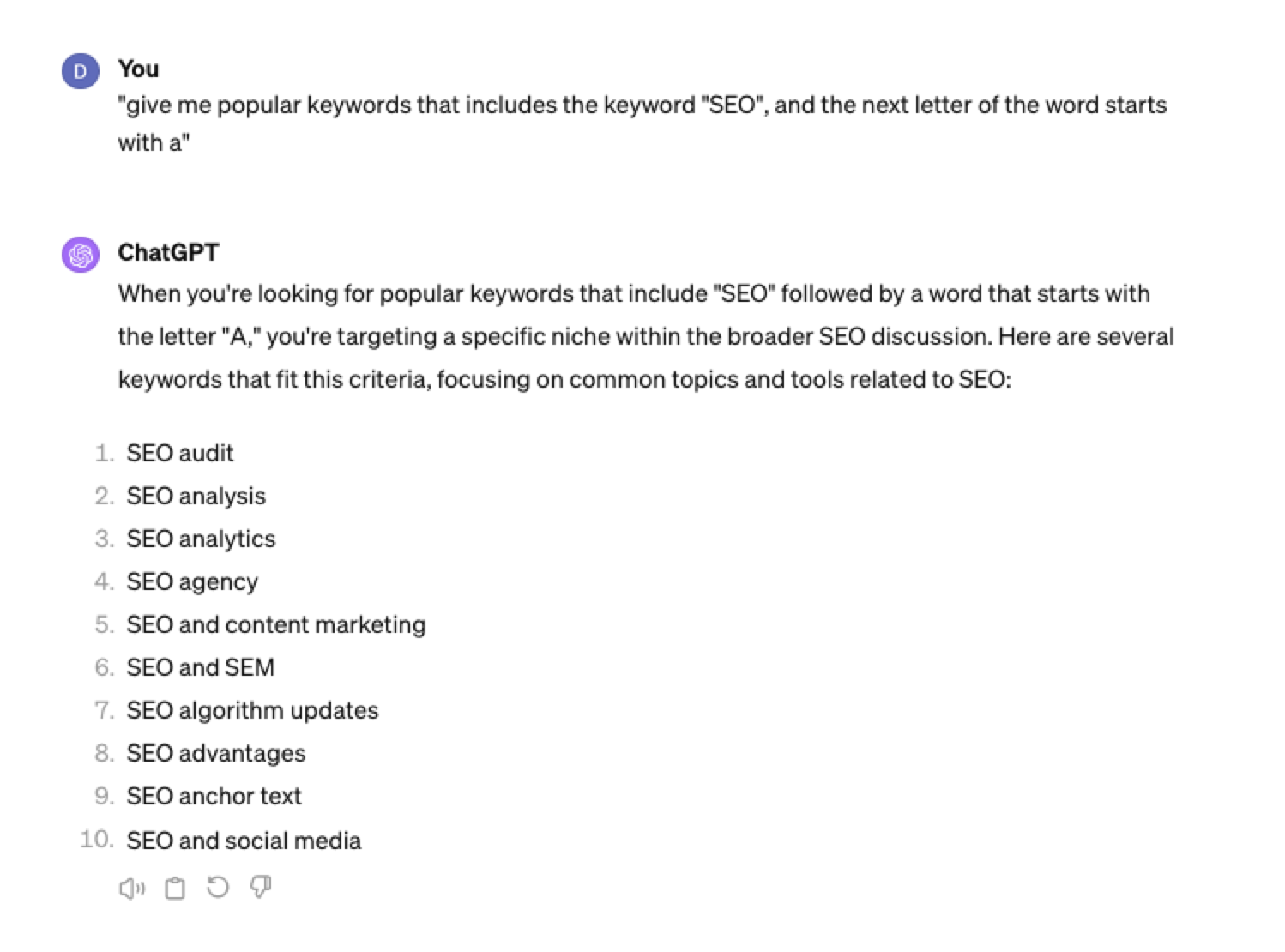 Screenshot from ChatGPT 4, April 2024
Screenshot from ChatGPT 4, April 2024Tip: Using the onion prompting method above, we can combine all this in one prompt.
“Give me five popular keywords that include “SEO” in the word, and the following letter starts with a. Once the answer has been done, move on to giving five more popular keywords that include “SEO” for each letter of the alphabet b to z.”
Generating Keyword Ideas Based On User Personas
When it comes to keyword research, understanding user personas is essential for understanding your target audience and keeping your keyword research focused and targeted. ChatGPT may help you get an initial understanding of customer personas.
Example prompt:
“For the topic of “{Topic}” list 10 keywords each for the different types of user personas”
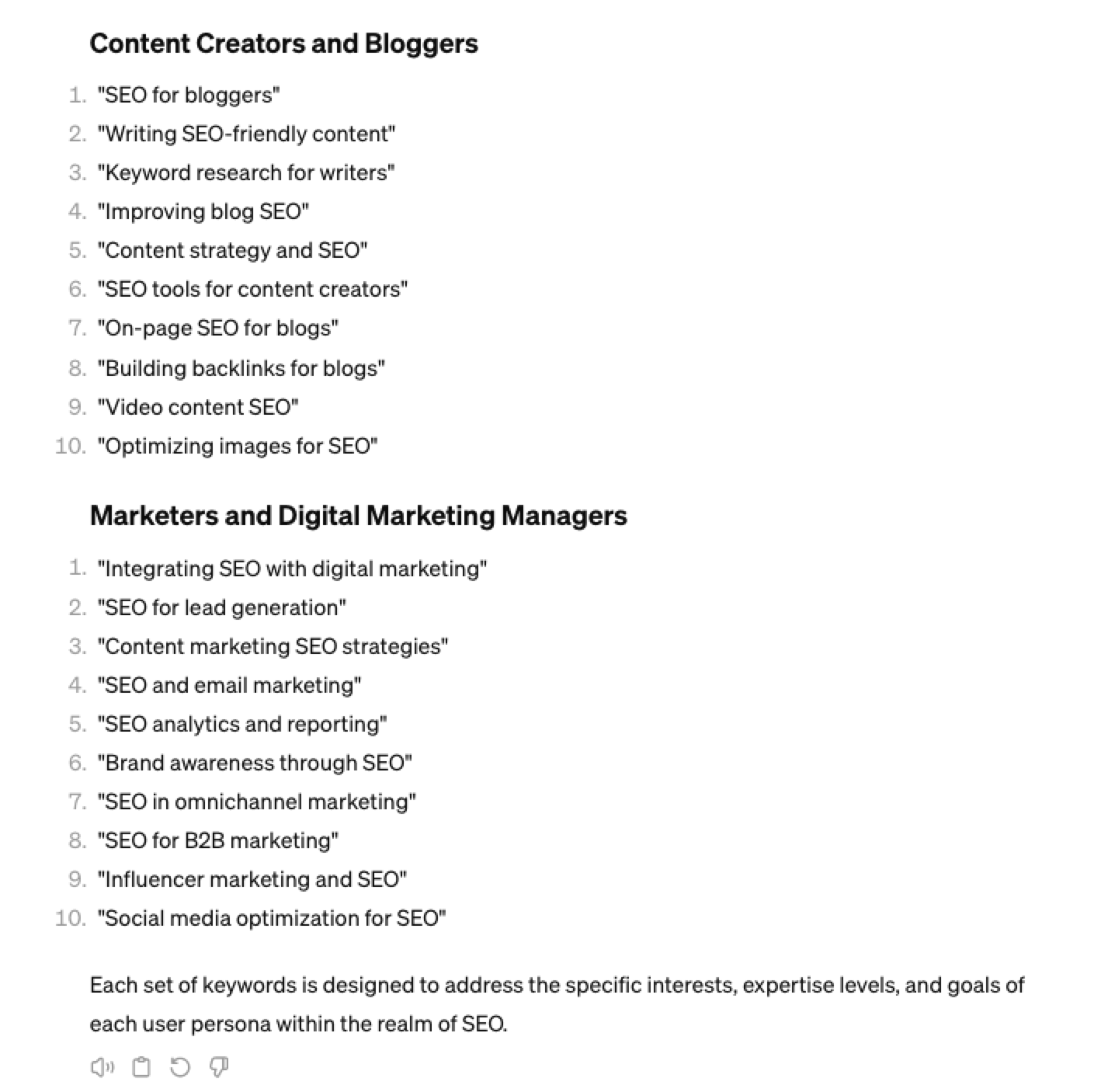 Screenshot from ChatGPT 4, April 2024
Screenshot from ChatGPT 4, April 2024You could even go a step further and ask for questions based on those topics that those specific user personas may be searching for:
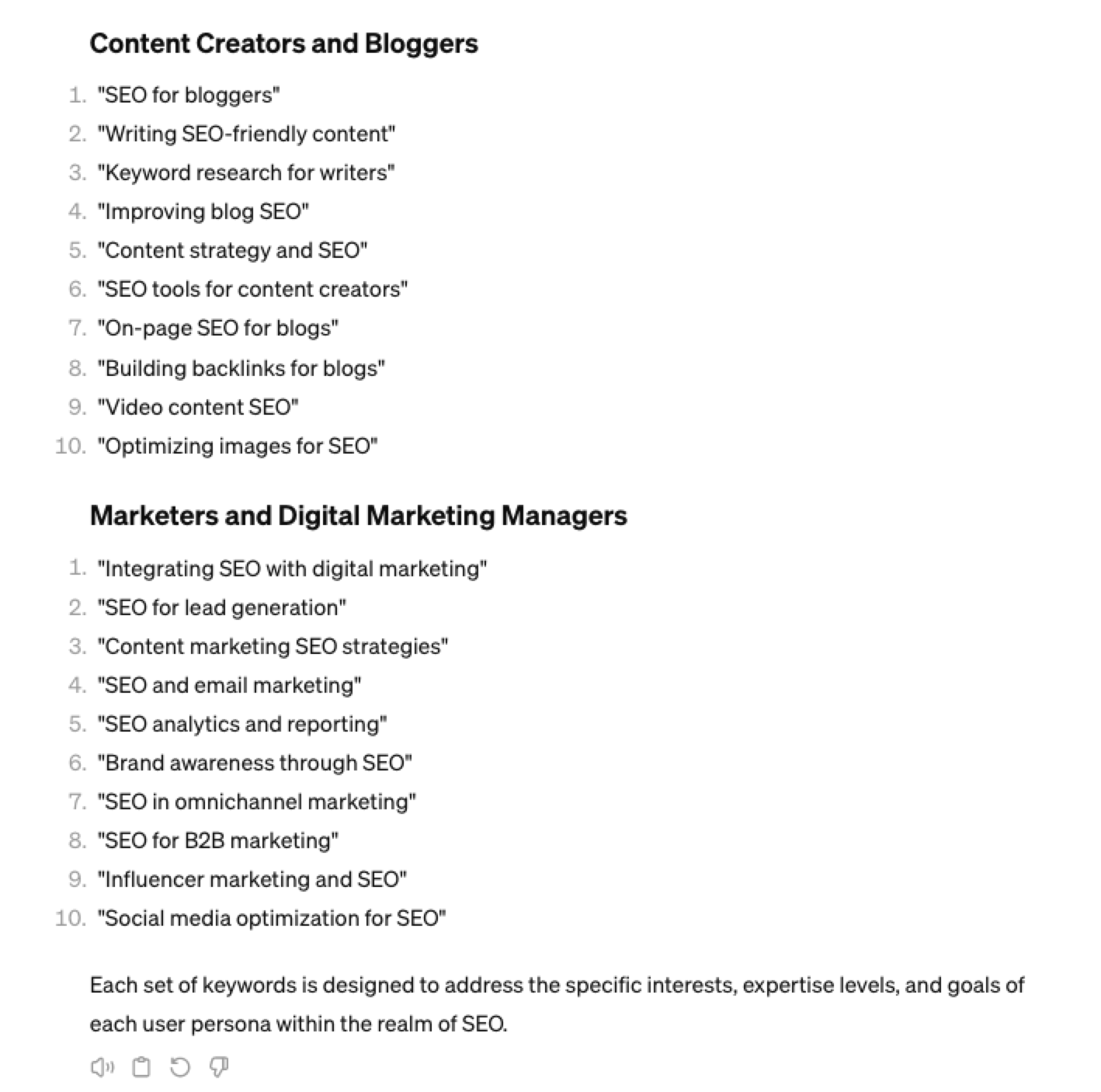 Screenshot ChatGPT 4, April 2024
Screenshot ChatGPT 4, April 2024As well as get the keywords to target based on those questions:
“For each question listed above for each persona, list the keywords, as well as the long-tail keywords to target, and put them in a table”
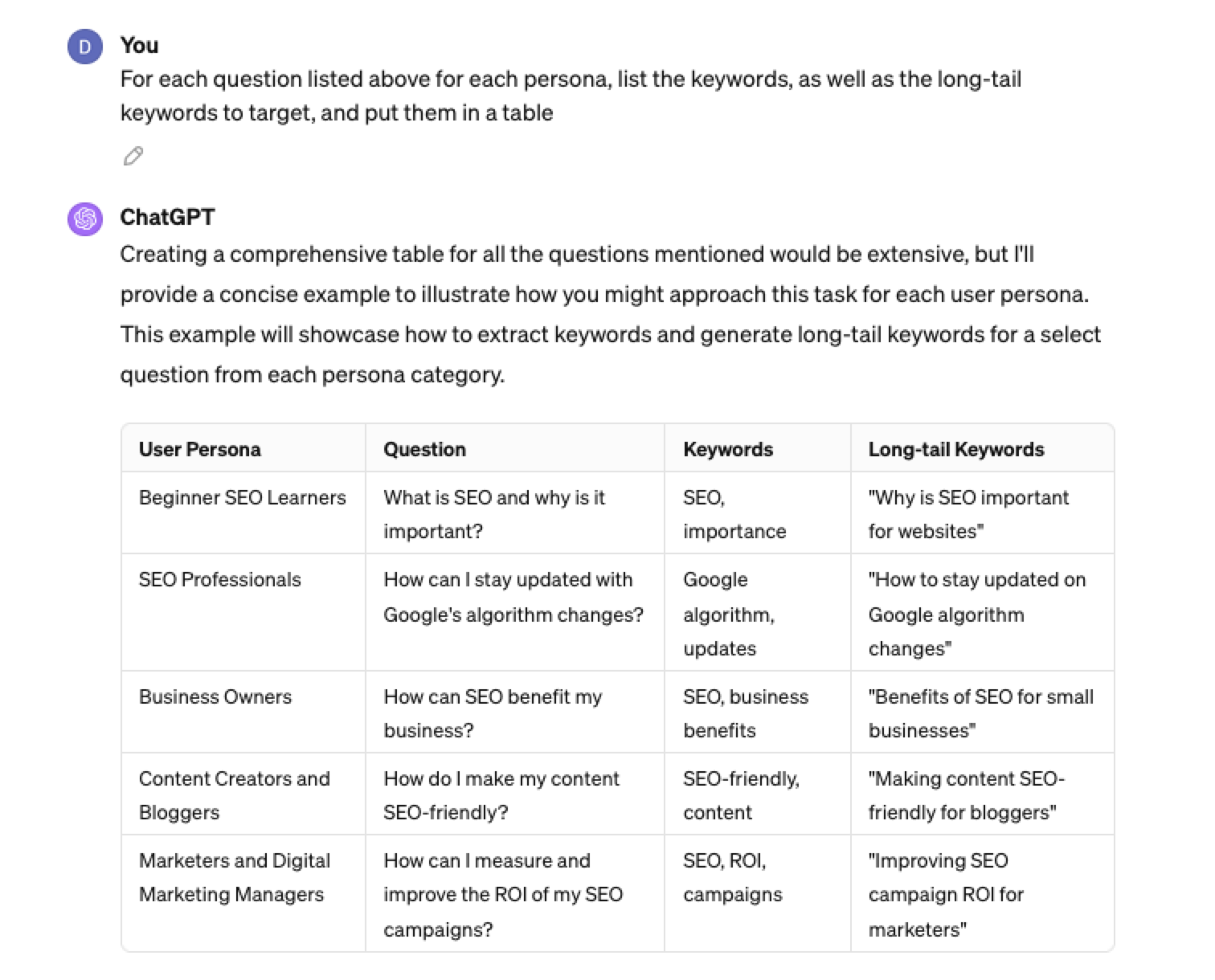 Screenshot from ChatGPT 4, April 2024
Screenshot from ChatGPT 4, April 2024Generating Keyword Ideas Using ChatGPT Based On Searcher Intent And User Personas
Understanding the keywords your target persona may be searching is the first step to effective keyword research. The next step is to understand the search intent behind those keywords and which content format may work best.
For example, a business owner who is new to SEO or has just heard about it may be searching for “what is SEO.”
However, if they are further down the funnel and in the navigational stage, they may search for “top SEO firms.”
You can query ChatGPT to inspire you here based on any topic and your target user persona.
SEO Example:
“For the topic of “{Topic}” list 10 keywords each for the different types of searcher intent that a {Target Persona} would be searching for”
ChatGPT For Keyword Research Admin
Here is how you can best use ChatGPT for keyword research admin tasks.
Using ChatGPT As A Keyword Categorization Tool
One of the use cases for using ChatGPT is for keyword categorization.
In the past, I would have had to devise spreadsheet formulas to categorize keywords or even spend hours filtering and manually categorizing keywords.
ChatGPT can be a great companion for running a short version of this for you.
Let’s say you have done keyword research in a keyword research tool, have a list of keywords, and want to categorize them.
You could use the following prompt:
“Filter the below list of keywords into categories, target persona, searcher intent, search volume and add information to a six-column table: List of keywords – [LIST OF KEYWORDS], Keyword Search Volume [SEARCH VOLUMES] and Keyword Difficulties [KEYWORD DIFFICUTIES].”
-
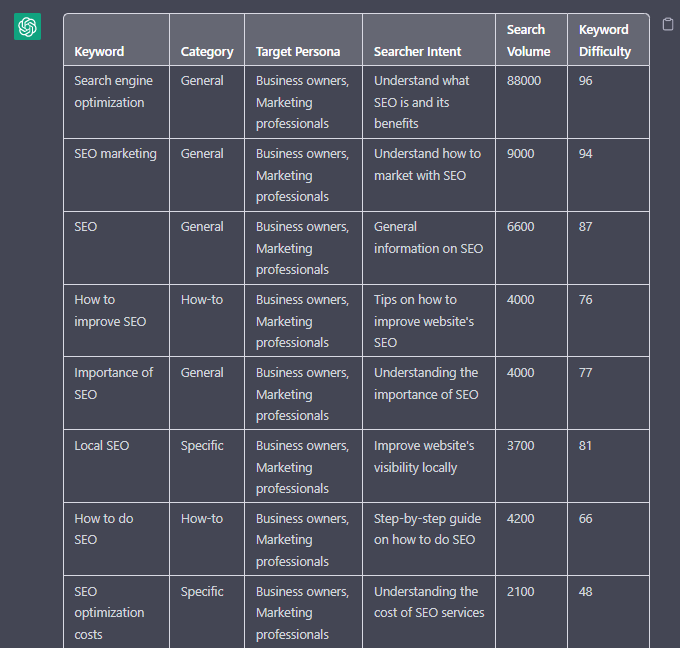 Screenshot from ChatGPT, April 2024
Screenshot from ChatGPT, April 2024
Tip: Add keyword metrics from the keyword research tools, as using the search volumes that a ChatGPT prompt may give you will be wildly inaccurate at best.
Using ChatGPT For Keyword Clustering
Another of ChatGPT’s use cases for keyword research is to help you cluster. Many keywords have the same intent, and by grouping related keywords, you may find that one piece of content can often target multiple keywords at once.
However, be careful not to rely only on LLM data for clustering. What ChatGPT may cluster as a similar keyword, the SERP or the user may not agree with. But it is a good starting point.
The big downside of using ChatGPT for keyword clustering is actually the amount of keyword data you can cluster based on the memory limits.
So, you may find a keyword clustering tool or script that is better for large keyword clustering tasks. But for small amounts of keywords, ChatGPT is actually quite good.
A great use small keyword clustering use case using ChatGPT is for grouping People Also Ask (PAA) questions.
Use the following prompt to group keywords based on their semantic relationships. For example:
“Organize the following keywords into groups based on their semantic relationships, and give a short name to each group: [LIST OF PAA], create a two-column table where each keyword sits on its own row.
-
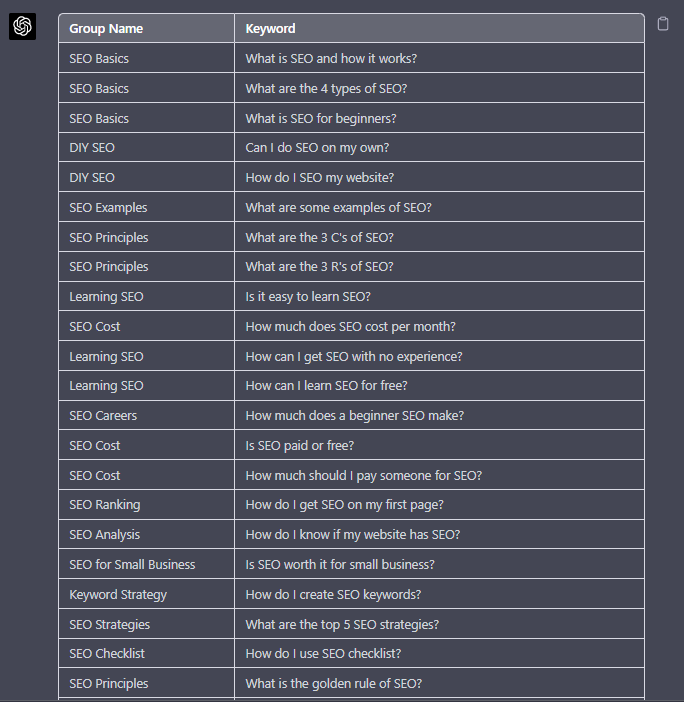 Screenshot from ChatGPT, April 2024
Screenshot from ChatGPT, April 2024
Using Chat GPT For Keyword Expansion By Patterns
One of my favorite methods of doing keyword research is pattern spotting.
Most seed keywords have a variable that can expand your target keywords.
Here are a few examples of patterns:
1. Question Patterns
(who, what, where, why, how, are, can, do, does, will)
“Generate [X] keywords for the topic “[Topic]” that contain any or all of the following “who, what, where, why, how, are, can, do, does, will”
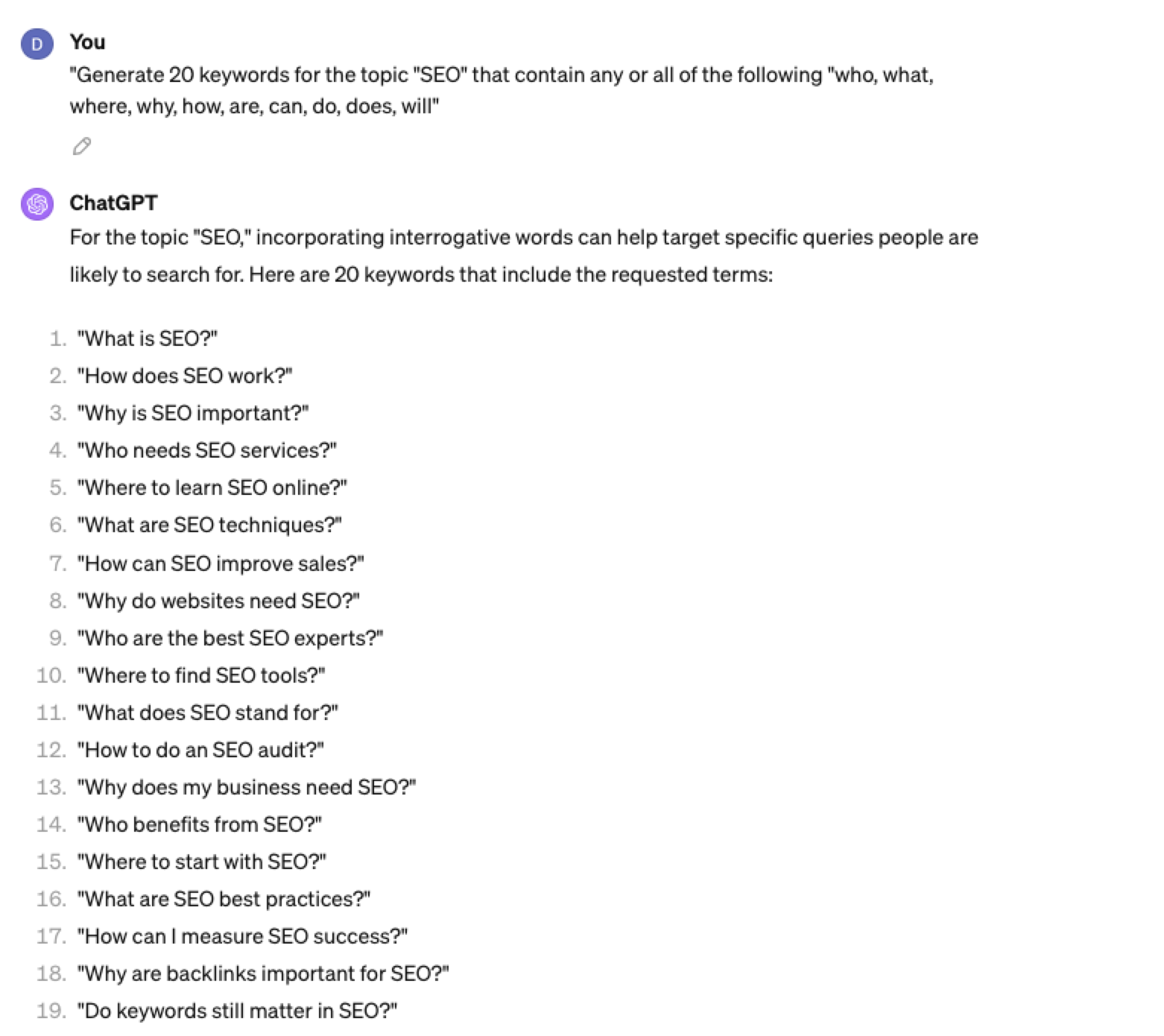 Screenshot ChatGPT 4, April 2024
Screenshot ChatGPT 4, April 20242. Comparison Patterns
Example:
“Generate 50 keywords for the topic “{Topic}” that contain any or all of the following “for, vs, alternative, best, top, review”
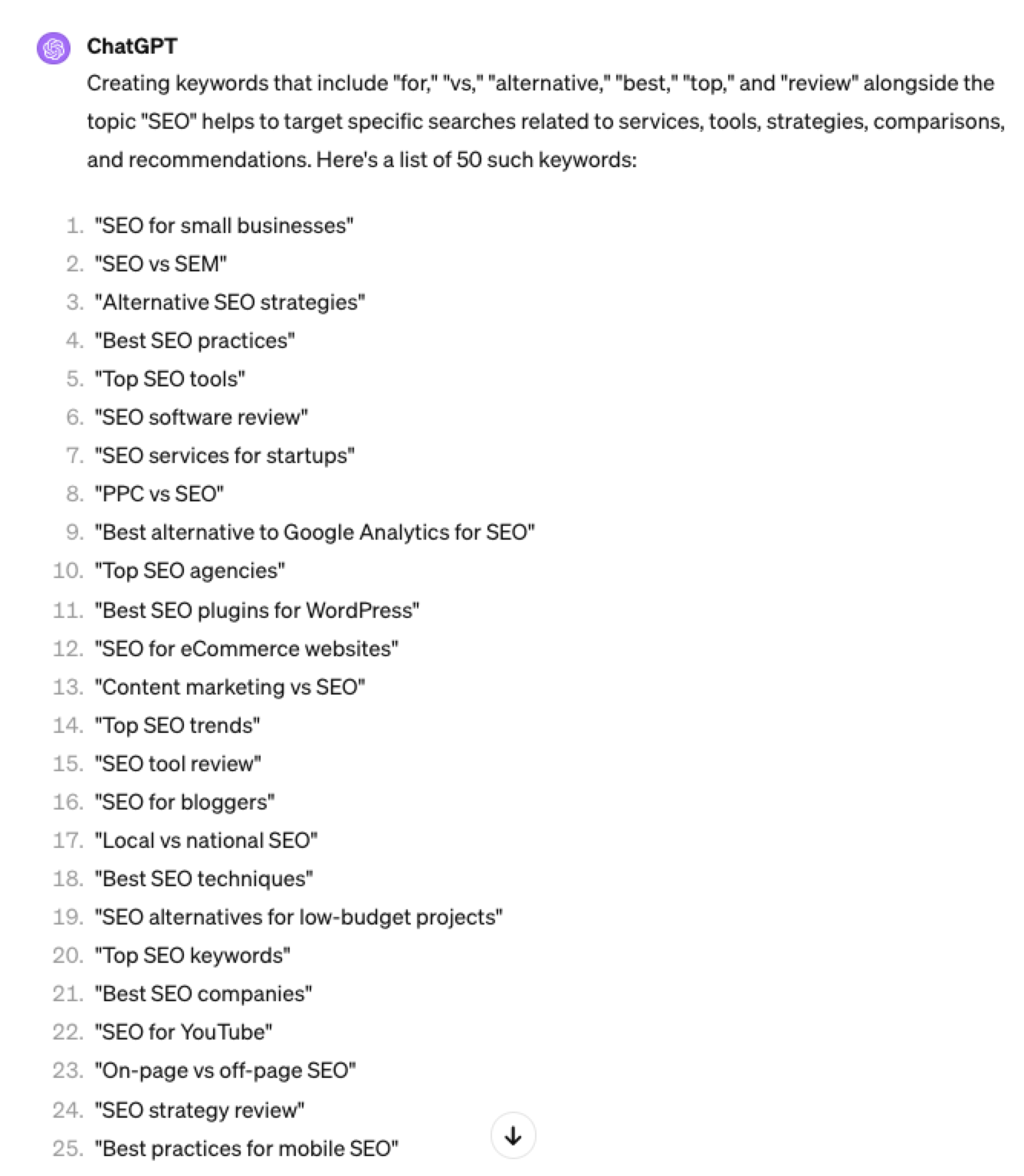 Screenshot ChatGPT 4, April 2024
Screenshot ChatGPT 4, April 20243. Brand Patterns
Another one of my favorite modifiers is a keyword by brand.
We are probably all familiar with the most popular SEO brands; however, if you aren’t, you could ask your AI friend to do the heavy lifting.
Example prompt:
“For the top {Topic} brands what are the top “vs” keywords”
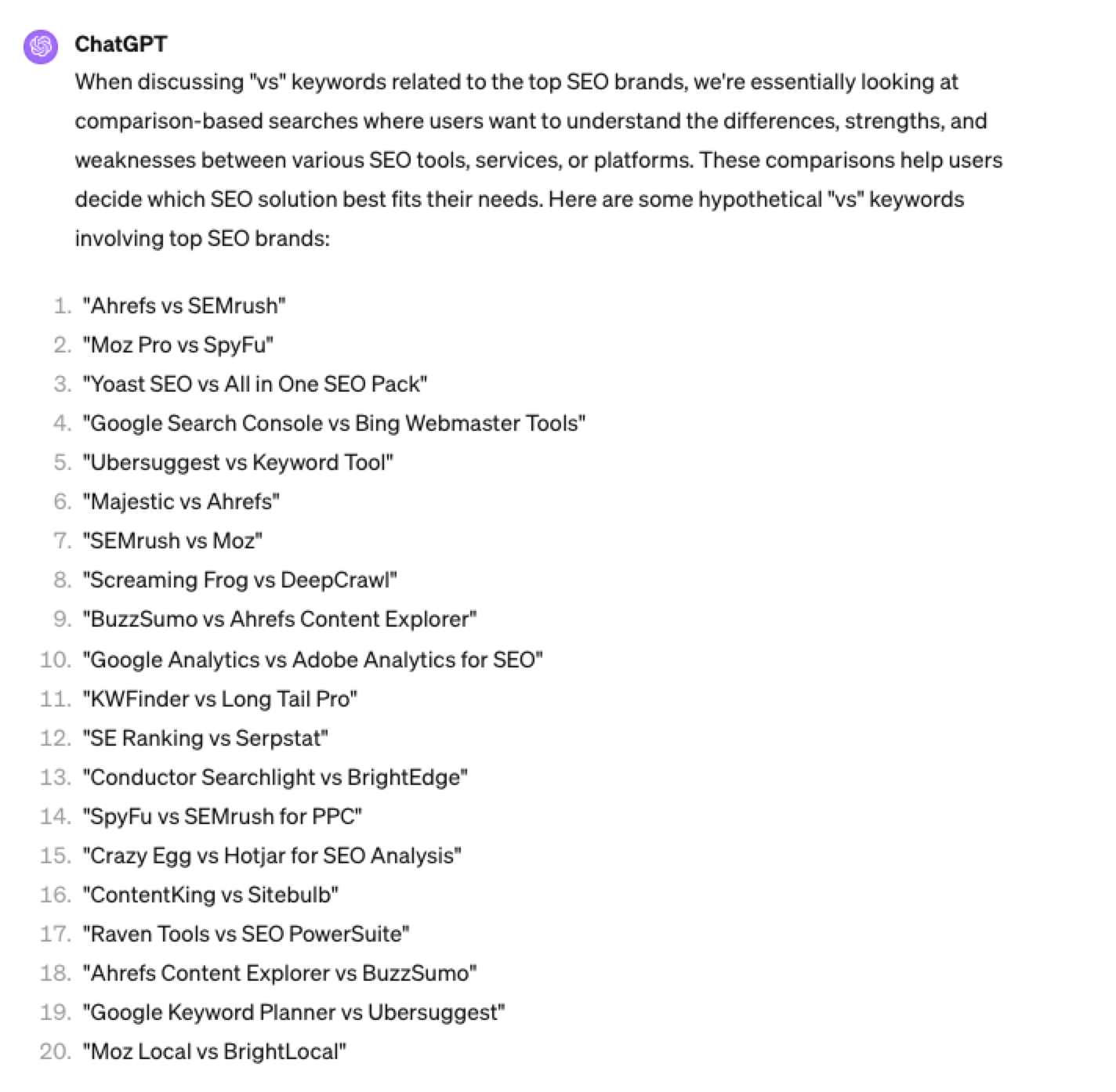 Screenshot ChatGPT 4, April 2024
Screenshot ChatGPT 4, April 20244. Search Intent Patterns
One of the most common search intent patterns is “best.”
When someone is searching for a “best {topic}” keyword, they are generally searching for a comprehensive list or guide that highlights the top options, products, or services within that specific topic, along with their features, benefits, and potential drawbacks, to make an informed decision.
Example:
“For the topic of “[Topic]” what are the 20 top keywords that include “best”
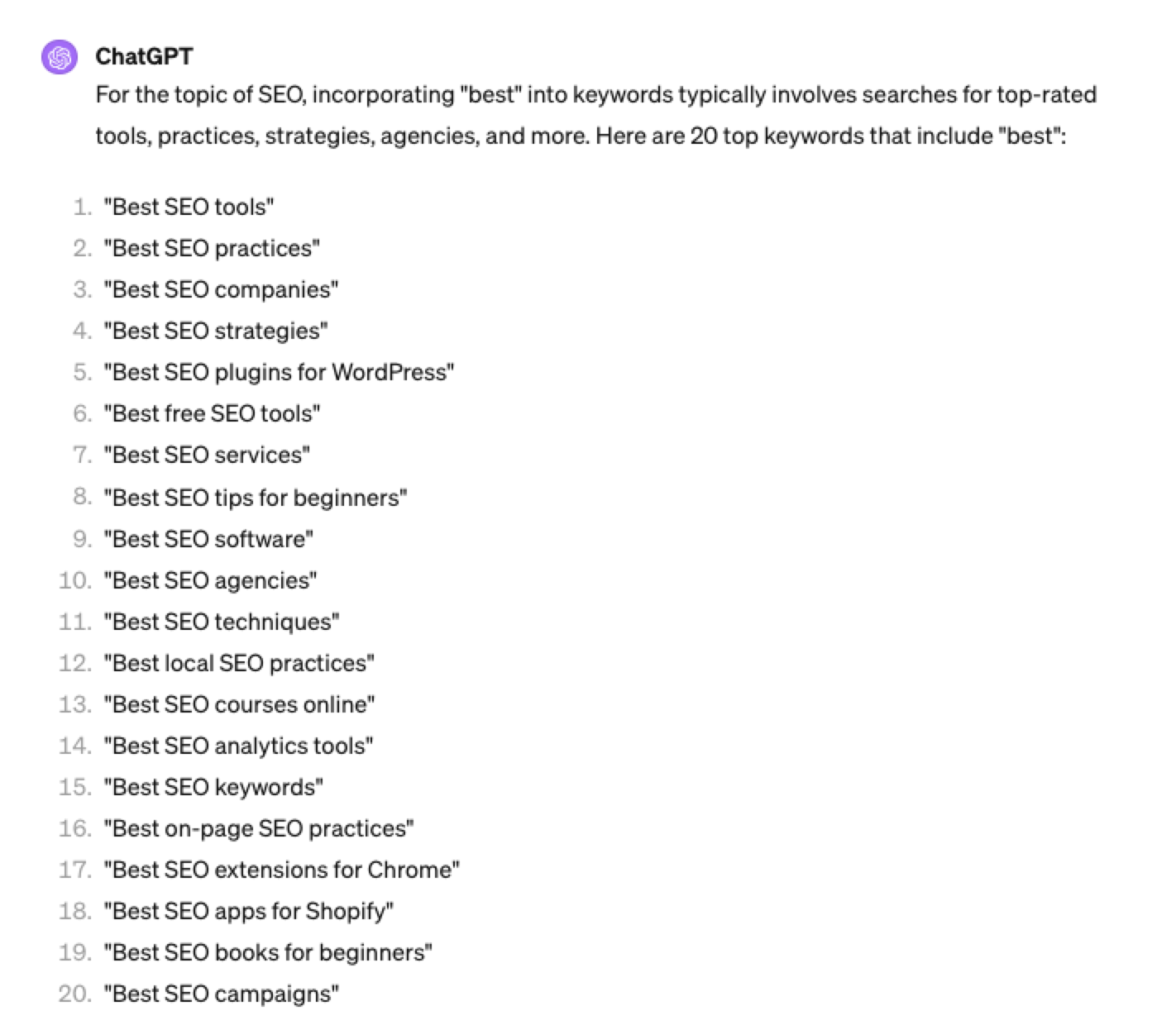 Screenshot ChatGPT 4, April 2024
Screenshot ChatGPT 4, April 2024Again, this guide to keyword research using ChatGPT has emphasized the ease of generating keyword research ideas by utilizing ChatGPT throughout the process.
Keyword Research Using ChatGPT Vs. Keyword Research Tools
Free Vs. Paid Keyword Research Tools
Like keyword research tools, ChatGPT has free and paid options.
However, one of the most significant drawbacks of using ChatGPT for keyword research alone is the absence of SEO metrics to help you make smarter decisions.
To improve accuracy, you could take the results it gives you and verify them with your classic keyword research tool – or vice versa, as shown above, uploading accurate data into the tool and then prompting.
However, you must consider how long it takes to type and fine-tune your prompt to get your desired data versus using the filters within popular keyword research tools.
For example, if we use a popular keyword research tool using filters, you could have all of the “best” queries with all of their SEO metrics:
-
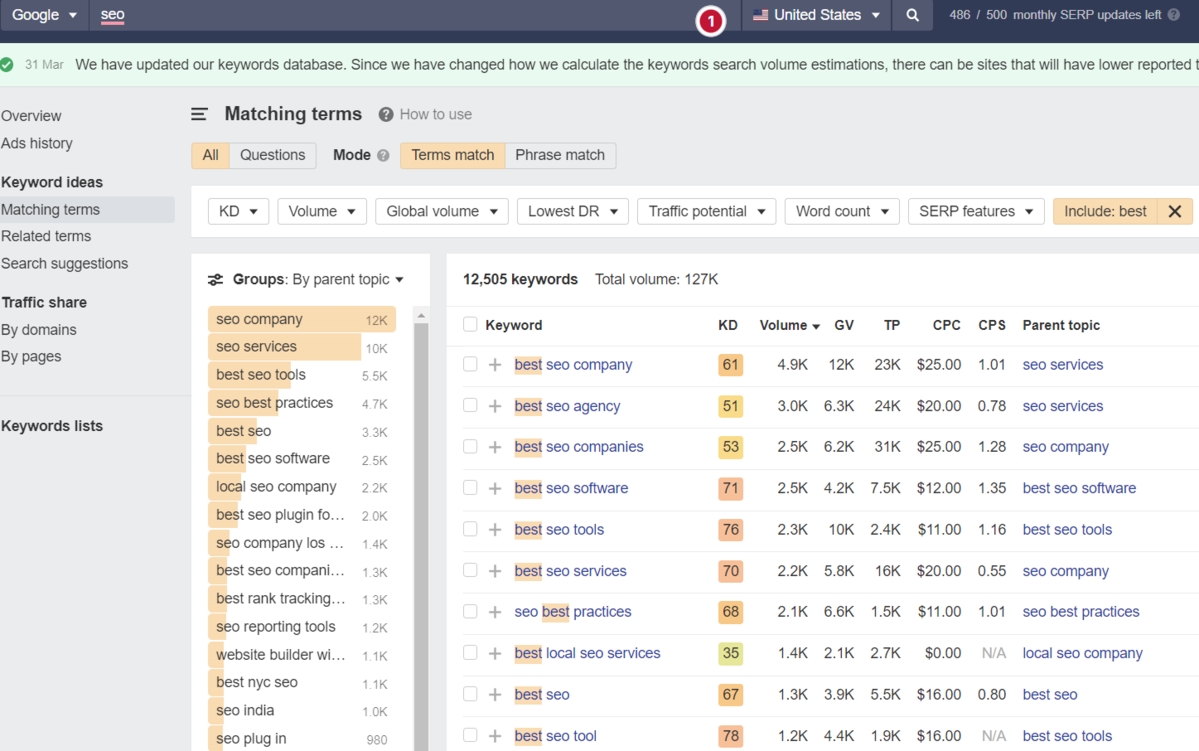 Screenshot from Ahrefs Keyword Explorer, March 2024
Screenshot from Ahrefs Keyword Explorer, March 2024
And unlike ChatGPT, generally, there is no token limit; you can extract several hundred, if not thousands, of keywords at a time.
As I have mentioned multiple times throughout this piece, you cannot blindly trust the data or SEO metrics it may attempt to provide you with.
The key is to validate the keyword research with a keyword research tool.
ChatGPT For International SEO Keyword Research
ChatGPT can be a terrific multilingual keyword research assistant.
For example, if you wanted to research keywords in a foreign language such as French. You could ask ChatGPT to translate your English keywords;
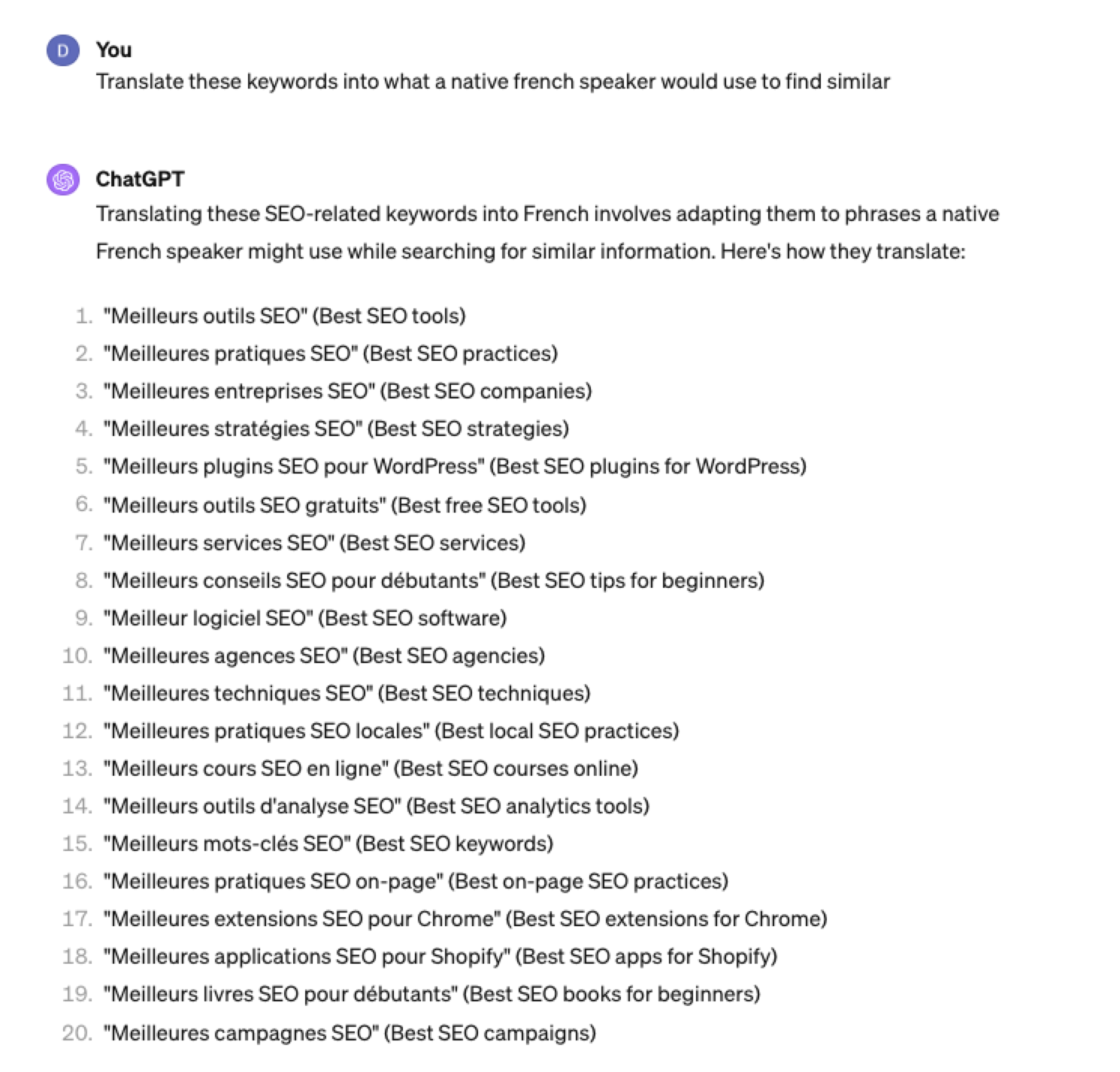 Screenshot ChatGPT 4, Apil 2024
Screenshot ChatGPT 4, Apil 2024- The key is to take the data above and paste it into a popular keyword research tool to verify.
- As you can see below, many of the keyword translations for the English keywords do not have any search volume for direct translations in French.
 Screenshot from Ahrefs Keyword Explorer, April 2024
Screenshot from Ahrefs Keyword Explorer, April 2024But don’t worry, there is a workaround: If you have access to a competitor keyword research tool, you can see what webpage is ranking for that query – and then identify the top keyword for that page based on the ChatGPT translated keywords that do have search volume.
-
-
 Screenshot from Ahrefs Keyword Explorer, April 2024
Screenshot from Ahrefs Keyword Explorer, April 2024
Or, if you don’t have access to a paid keyword research tool, you could always take the top-performing result, extract the page copy, and then ask ChatGPT what the primary keyword for the page is.
Key Takeaway
-
ChatGPT can be an expert on any topic and an invaluable keyword research tool. However, it is another tool to add to your toolbox when doing keyword research; it does not replace traditional keyword research tools.
As shown throughout this tutorial, from making up keywords at the beginning to inaccuracies around data and translations, ChatGPT can make mistakes when used for keyword research.
You cannot blindly trust the data you get back from ChatGPT.
However, it can offer a shortcut to understanding any topic for which you need to do keyword research and, as a result, save you countless hours.
But the key is how you prompt.
The prompts I shared with you above will help you understand a topic in minutes instead of hours and allow you to better seed keywords using keyword research tools.
It can even replace mundane keyword clustering tasks that you used to do with formulas in spreadsheets or generate ideas based on keywords you give it.
Paired with traditional keyword research tools, ChatGPT for keyword research can be a powerful tool in your arsenal.
More resources:
Featured Image: Tatiana Shepeleva/Shutterstock
SEO
OpenAI Expected to Integrate Real-Time Data In ChatGPT

Sam Altman, CEO of OpenAI, dispelled rumors that a new search engine would be announced on Monday, May 13. Recent deals have raised the expectation that OpenAI will announce the integration of real-time content from English, Spanish, and French publications into ChatGPT, complete with links to the original sources.
OpenAI Search Is Not Happening
Many competing search engines have tried and failed to challenge Google as the leading search engine. A new wave of hybrid generative AI search engines is currently trying to knock Google from the top spot with arguably very little success.
Sam Altman is on record saying that creating a search engine to compete against Google is not a viable approach. He suggested that technological disruption was the way to replace Google by changing the search paradigm altogether. The speculation that Altman is going to announce a me-too search engine on Monday never made sense given his recent history of dismissing the concept as a non-starter.
So perhaps it’s not a surprise that he recently ended the speculation by explicitly saying that he will not be announcing a search engine on Monday.
He tweeted:
“not gpt-5, not a search engine, but we’ve been hard at work on some new stuff we think people will love! feels like magic to me.”
“New Stuff” May Be Iterative Improvement
It’s quite likely that what’s going to be announced is iterative which means it improves ChatGPT but not replaces it. This fits into how Altman recently expressed his approach with ChatGPT.
He remarked:
“And it does kind of suck to ship a product that you’re embarrassed about, but it’s much better than the alternative. And in this case in particular, where I think we really owe it to society to deploy iteratively.
There could totally be things in the future that would change where we think iterative deployment isn’t such a good strategy, but it does feel like the current best approach that we have and I think we’ve gained a lot from from doing this and… hopefully the larger world has gained something too.”
Improving ChatGPT iteratively is Sam Altman’s preference and recent clues point to what those changes may be.
Recent Deals Contain Clues
OpenAI has been making deals with news media and User Generated Content publishers since December 2023. Mainstream media has reported these deals as being about licensing content for training large language models. But they overlooked a a key detail that we reported on last month which is that these deals give OpenAI access to real-time information that they stated will be used to give attribution to that real-time data in the form of links.
That means that ChatGPT users will gain the ability to access real-time news and to use that information creatively within ChatGPT.
Dotdash Meredith Deal
Dotdash Meredith (DDM) is the publisher of big brand publications such as Better Homes & Gardens, FOOD & WINE, InStyle, Investopedia, and People magazine. The deal that was announced goes way beyond using the content as training data. The deal is explicitly about surfacing the Dotdash Meredith content itself in ChatGPT.
The announcement stated:
“As part of the agreement, OpenAI will display content and links attributed to DDM in relevant ChatGPT responses. …This deal is a testament to the great work OpenAI is doing on both fronts to partner with creators and publishers and ensure a healthy Internet for the future.
Over 200 million Americans each month trust our content to help them make decisions, solve problems, find inspiration, and live fuller lives. This partnership delivers the best, most relevant content right to the heart of ChatGPT.”
A statement from OpenAI gives credibility to the speculation that OpenAI intends to directly show licensed third-party content as part of ChatGPT answers.
OpenAI explained:
“We’re thrilled to partner with Dotdash Meredith to bring its trusted brands to ChatGPT and to explore new approaches in advancing the publishing and marketing industries.”
Something that DDM also gets out of this deal is that OpenAI will enhance DDM’s in-house ad targeting in order show more tightly focused contextual advertising.
Le Monde And Prisa Media Deals
In March 2024 OpenAI announced a deal with two global media companies, Le Monde and Prisa Media. Le Monde is a French news publication and Prisa Media is a Spanish language multimedia company. The interesting aspects of these two deals is that it gives OpenAI access to real-time data in French and Spanish.
Prisa Media is a global Spanish language media company based in Madrid, Spain that is comprised of magazines, newspapers, podcasts, radio stations, and television networks. It’s reach extends from Spain to America. American media companies include publications in the United States, Argentina, Bolivia, Chile, Colombia, Costa Rica, Ecuador, Mexico, and Panama. That is a massive amount of real-time information in addition to a massive audience of millions.
OpenAI explicitly announced that the purpose of this deal was to bring this content directly to ChatGPT users.
The announcement explained:
“We are continually making improvements to ChatGPT and are supporting the essential role of the news industry in delivering real-time, authoritative information to users. …Our partnerships will enable ChatGPT users to engage with Le Monde and Prisa Media’s high-quality content on recent events in ChatGPT, and their content will also contribute to the training of our models.”
That deal is not just about training data. It’s about bringing current events data to ChatGPT users.
The announcement elaborated in more detail:
“…our goal is to enable ChatGPT users around the world to connect with the news in new ways that are interactive and insightful.”
As noted in our April 30th article that revealed that OpenAI will show links in ChatGPT, OpenAI intends to show third party content with links to that content.
OpenAI commented on the purpose of the Le Monde and Prisa Media partnership:
“Over the coming months, ChatGPT users will be able to interact with relevant news content from these publishers through select summaries with attribution and enhanced links to the original articles, giving users the ability to access additional information or related articles from their news sites.”
There are additional deals with other groups like The Financial Times which also stress that this deal will result in a new ChatGPT feature that will allow users to interact with real-time news and current events .
OpenAI’s Monday May 13 Announcement
There are many clues that the announcement on Monday will be that ChatGPT users will gain the ability to interact with content about current events. This fits into the terms of recent deals with news media organizations. There may be other features announced as well but this part is something that there are many clues pointing to.
Watch Altman’s interview at Stanford University
Featured Image by Shutterstock/photosince
SEO
Google’s Strategies For Dealing With Content Decay

In the latest episode of the Search Off The Record podcast, Google Search Relations team members John Mueller and Lizzi Sassman did a deep dive into dealing with “content decay” on websites.
Outdated content is a natural issue all sites face over time, and Google has outlined strategies beyond just deleting old pages.
While removing stale content is sometimes necessary, Google recommends taking an intentional, format-specific approach to tackling content decay.
Archiving vs. Transitional Guides
Google advises against immediately removing content that becomes obsolete, like materials referencing discontinued products or services.
Removing content too soon could confuse readers and lead to a poor experience, Sassman explains:
“So, if I’m trying to find out like what happened, I almost need that first thing to know. Like, “What happened to you?” And, otherwise, it feels almost like an error. Like, “Did I click a wrong link or they redirect to the wrong thing?””
Sassman says you can avoid confusion by providing transitional “explainer” pages during deprecation periods.
A temporary transition guide informs readers of the outdated content while steering them toward updated resources.
Sassman continues:
“That could be like an intermediary step where maybe you don’t do that forever, but you do it during the transition period where, for like six months, you have them go funnel them to the explanation, and then after that, all right, call it a day. Like enough people know about it. Enough time has passed. We can just redirect right to the thing and people aren’t as confused anymore.”
When To Update Vs. When To Write New Content
For reference guides and content that provide authoritative overviews, Google suggests updating information to maintain accuracy and relevance.
However, for archival purposes, major updates may warrant creating a new piece instead of editing the original.
Sassman explains:
“I still want to retain the original piece of content as it was, in case we need to look back or refer to it, and to change it or rehabilitate it into a new thing would almost be worth republishing as a new blog post if we had that much additional things to say about it.”
Remove Potentially Harmful Content
Google recommends removing pages in cases where the outdated information is potentially harmful.
Sassman says she arrived at this conclusion when deciding what to do with a guide involving obsolete structured data:
“I think something that we deleted recently was the “How to Structure Data” documentation page, which I thought we should just get rid of it… it almost felt like that’s going to be more confusing to leave it up for a period of time.
And actually it would be negative if people are still adding markup, thinking they’re going to get something. So what we ended up doing was just delete the page and redirect to the changelog entry so that, if people clicked “How To Structure Data” still, if there was a link somewhere, they could still find out what happened to that feature.”
Internal Auditing Processes
To keep your content current, Google advises implementing a system for auditing aging content and flagging it for review.
Sassman says she sets automated alerts for pages that haven’t been checked in set periods:
“Oh, so we have a little robot to come and remind us, “Hey, you should come investigate this documentation page. It’s been x amount of time. Please come and look at it again to make sure that all of your links are still up to date, that it’s still fresh.””
Context Is Key
Google’s tips for dealing with content decay center around understanding the context of outdated materials.
You want to prevent visitors from stumbling across obsolete pages without clarity.
Additional Google-recommended tactics include:
- Prominent banners or notices clarifying a page’s dated nature
- Listing original publish dates
- Providing inline annotations explaining how older references or screenshots may be obsolete
How This Can Help You
Following Google’s recommendations for tackling content decay can benefit you in several ways:
- Improved user experience: By providing clear explanations, transition guides, and redirects, you can ensure that visitors don’t encounter confusing or broken pages.
- Maintained trust and credibility: Removing potentially harmful or inaccurate content and keeping your information up-to-date demonstrates your commitment to providing reliable and trustworthy resources.
- Better SEO: Regularly auditing and updating your pages can benefit your website’s search rankings and visibility.
- Archival purposes: By creating new content instead of editing older pieces, you can maintain a historical record of your website’s evolution.
- Streamlined content management: Implementing internal auditing processes makes it easier to identify and address outdated or problematic pages.
By proactively tackling content decay, you can keep your website a valuable resource, improve SEO, and maintain an organized content library.
Listen to the full episode of Google’s podcast below:
Featured Image: Stokkete/Shutterstock
-

 PPC5 days ago
PPC5 days agoHow the TikTok Algorithm Works in 2024 (+9 Ways to Go Viral)
-

 MARKETING7 days ago
MARKETING7 days agoA Recap of Everything Marketers & Advertisers Need to Know
-

 SEO4 days ago
SEO4 days agoHow to Use Keywords for SEO: The Complete Beginner’s Guide
-

 SEO6 days ago
SEO6 days agoBlog Post Checklist: Check All Prior to Hitting “Publish”
-

 MARKETING5 days ago
MARKETING5 days agoHow To Protect Your People and Brand
-

 SEARCHENGINES6 days ago
SEARCHENGINES6 days agoGoogle Started Enforcing The Site Reputation Abuse Policy
-

 PPC6 days ago
PPC6 days agoHow to Craft Compelling Google Ads for eCommerce
-

 MARKETING6 days ago
MARKETING6 days agoElevating Women in SEO for a More Inclusive Industry






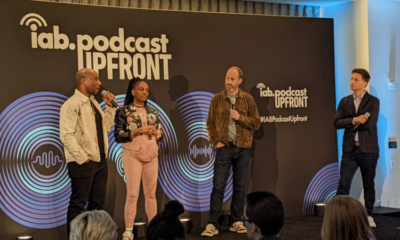







You must be logged in to post a comment Login